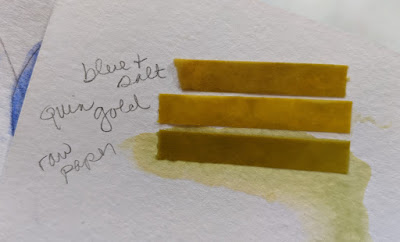In some ways, 2020 has been a very good year for me. But that is set against loss, both my own and others’.
| Happy New Year! by Carol L. Douglas |
If I had a bucket list, Tierra del Fuego would certainly be on it. So, when, in March, I had the opportunity to paint there and in Patagonia with my pal Jane Chapin, I jumped. COVID-19 was still just a rumble from China, albeit moving closer. Within 48 hours of our arrival, the Argentines quarantined us in the mountainous region near the Chilean border. As the first snows of the year hit the higher elevations, we painted glaciers and meted out our remaining canvases.
My uncle Bob, from whom I inherited the travel bug, had been in Patagonia a few years back. He was following our exploits by text. He never learned that we made it home, because on March 29, he became an early casualty of the pandemic. It is the worst grief I’ve sustained since the loss of my parents.
 |
|
Glaciar Cagliero from Rio Electrico, oil on canvasboard, by Carol L. Douglas |
I came home feeling very deflated. Painting events were cancelled; my own gallery in Rockport couldn’t open. I asked our local police chief if the new regulations would allow plein air classes; he thought no. The windjammer American Eagle, on which I was scheduled to teach two workshops, cancelled its season. My workshop at Schoodic was rescheduled for October, but it hardly mattered. Nobody was signing up for anything, anyways. By June, my revenues to date were down $10,000 from 2019, and that didn’t include the cost of getting back from Argentina. If I’ve ever been inclined to quit, it was then.
There are two important lessons you can take from your Christian neighbors. The first is to live in faith rather than in fear. That doesn’t mean being foolish. I follow the quarantine and testing regulations of the states to which I travel; I use hand sanitizer and a mask; I avoid unnecessary public exposure. I do not, however, let COVID paralyze me. I recognize that the ultimate disposition of my life isn’t in my hands.
 |
| The Dooryard, oil on canvasboard, by Carol L. Douglas, was painted for an event that had to go online; the results were decidedly mixed. |
That’s true regardless of your beliefs, by the way. You can do nothing to insulate yourself from the ultimate reality of death. So many Americans (including my uncle) followed the rules punctiliously, but the virus still found them.
The second is that humans need to be flexible to survive tough times. Mature Christians listen to the voice of the Holy Spirit, even when it asks them to do odd things. Non-believers may call this ‘listening to their gut,’ but the basic requirement is the same—one has to be open to new ideas. That’s not so easy at my age, when system and structure have had decades to accrete.
 |
| On the other hand, Cape Elizabeth’s Paint for Preservation was a hit, even online. |
I was extremely resistant to teaching online. I didn’t think it would be a good experience for my students. However, my friend Mary Byrom encouraged and coached me, and today I think it’s at least as good as live classes. It has forced me to be more proactive in designing lessons. That, in turn, has given me the nucleus of the book I’ve always intended to write.
In the end, much happened that was lovely. I suspended minimum enrollment requirements and ended up teaching three successful workshops—at Schoodic, in New Mexico, and in Florida—despite concerns about travel. I learned a new technology, and even made some pretty terrible painting videos. Learning is growth; in that regard, 2020 has been a very good year for me. But that is set against loss, both my own and others’. So much of life is like that, a mix of sorrow and joy.



























